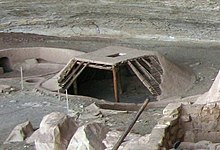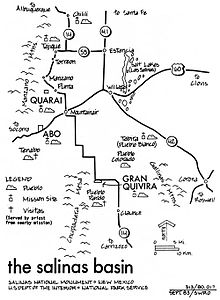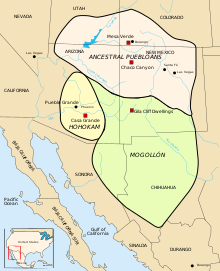| This article needs additional citations for verification. Please help improve this article by adding citations to reliable sources. Unsourced material may be challenged and removed. Find sources: "Ancestral Puebloan dwellings" – news · newspapers · books · scholar · JSTOR (July 2011) (Learn how and when to remove this message) |
| Part of a series on |
| Ancestral Puebloan dwellings |
|---|

Hundreds of Ancestral Puebloan dwellings are found across the American Southwest. With almost all constructed well before 1492 CE, these Puebloan towns and villages are located throughout the geography of the Southwest.
Many of these dwellings included various defensive positions, like the high steep mesas such as at the ancient Mesa Verde complex or the present-day Acoma "Sky City" Pueblo. Earlier than 900 CE progressing past the 13th century, the population complexes appear to have been major cultural centers for the Pueblo peoples. There were also settlements scattered throughout the region of varying sizes.
Cultures

Ancestral cultures
Further information: Ancestral PuebloansAncestral Puebloans spanned Northern Arizona and New Mexico, Southern Colorado and Utah, and a part of Southeastern Nevada. They primarily lived north of the Patayan, Sinagua, Hohokam, Trincheras, Mogollon, and Casas Grandes cultures of the Southwest and south of the Fremont culture of the Great Basin .
Contemporary cultures
Main article: Pueblo people Further information: PuebloThere are 21 federally recognized pueblos in the United States today. Rio Grande pueblos are known as eastern Pueblos; Zuni, Hopi, and sometimes Acoma and Laguna are known as western Pueblos.
|
|
|
Geography

The dwellings of the Pueblo peoples are located throughout the American Southwest and north central Mexico. The American states of New Mexico, Texas, Colorado, Utah, Nevada, and Arizona all have evidence of Pueblo peoples' dwellings; the Mexican states of Chihuahua and Sonora do as well.
Eras

Archaeologists have agreed on three main periods of ancient occupation by Pueblo peoples throughout the Southwest called Pueblo I, Pueblo II, and Pueblo III.
- Pueblo I (750–900 CE). Pueblo buildings were built with stone, windows facing south, and in U, E and L shapes. The buildings were located more closely together and reflected deepening religious celebration. Towers were built near kivas and likely used for look-outs. Pottery became more versatile, not just for cooking, but now included pitchers, ladles, bowls, jars and dishware for food and drink. White pottery with black designs emerged, the pigments coming from plants. Water management and conservation techniques, including the use of reservoirs and silt-retaining dams also emerged during this period. Midway through this period, about 900 CE, the number of Hovenweep residential sites increased.
- Pueblo II (900–1150 CE). During the Pueblo II period there was an increase in population that resulted in creation of more than 10,000 sites in 150 years. Since much of the land was arid, the people supplemented their diet by hunting, foraging and trading pottery for food. By the end of the period, there were two-story dwellings made primarily of stone masonry, the presence of towers, and family and community kivas.
- Pueblo III (1150–1300 CE). Rohn and Ferguson, authors of Puebloan ruins of the Southwest, state that during the Pueblo III period there was a significant community change. Moving in from dispersed farmsteads into community centers at pueblos canyon heads or cliff dwellings on canyon shelves. Population peaked between 1200 and 1250 to more than 20,000 in the Mesa Verde region. By 1300 Ancient Pueblo People abandoned their settlements, as the result of climate changes and food shortage, and moved south to villages in Arizona and New Mexico.
Architecture
The ancient population centers such as Chaco Canyon, Mesa Verde, and Bandelier for which the Ancestral Puebloans are renowned consisted of apartment-like complexes and structures made from stone, adobe mud, and other local material, or were carved into the sides of canyon walls.
The structures contained within these alcoves were mostly blocks of hard sandstone, held together and plastered with adobe mortar. Specific constructions had many similarities, but were generally unique in form due to the individual topography of different alcoves along the canyon walls.
Decorative motifs for these sandstone/mortar constructions, both cliff dwellings and otherwise, included T-shaped windows and doors.
Construction characteristics

Most notable Pueblo structures were made of adobe and built like an apartment complex. Generally speaking, Pueblo buildings feature a box base, smaller box on top, and an even smaller one on top of that, with the tallest reaching four and five stories. There were floors for storage and defense, living and religious ceremonies. Generally, there were no doors on the bottom floor until recent times. This limited access to the buildings so movable ladders were key elements. One ladder would take inhabitants to the patio, or second floor, and another led through an opening through a roof and onto the first floor. Other ladders led to higher floors.
Architectural elements

The key technology of the Pueblo peoples was their irrigation techniques. These were used throughout their dwellings, and often determined the siting of communities.
Many pueblos feature T-shaped doors in adobe walls. Usually one meter wide, they are wider on top and narrower below. The Great house-style pueblos were constructed on a box system. Builders used molds to pour compacted mud without organic material. The exterior was stuccoed with sand, lime and oyster dust shells, then it was painted blue, green, or pink. Made without foundations, the walls were built from slots that were 25 centimeters deep. The doors were proportional to the size of the room. Stairs, ramps, and ladders were built to allow access to the buildings.

There are a number of consistent features surrounding the dwellings. They include water retention structures like the Mesa Verde Reservoirs, and stone towers. Each were about 60 meters long, 33 meters apart, and 2.5 meters high. In 2009 it was suggested that the shape of an oval bowl with curved sides and the uneven embankments on the long sides are unsuited for any kind of ball game; On the other hand, they appear to correspond with dance floors of the Tohono O'odham, used for Wi:gita ceremonies until at least the 1930s.
For a period of time, pueblos throughout the Southwest were connected by a network of roads that radiated from Chaco Canyon, which is believed to have been a cultural epicenter. Remnants of this roadway system are evident throughout New Mexico and Arizona today.
Types of dwellings
In addition to the movable structures used by other Native Americans across North and South America, the Pueblo peoples created distinctive structures for living, worshiping, defense, storage, and daily life.
- Pueblo – Referring to both a certain style of Puebloan architecture and groups of people themselves, the term pueblo is used in architectural terms to describe multistory, apartment-like buildings made of adobe. In this article they are called "great houses".
- Great houses – Generally built on flat plains throughout the Southwest, the great house-style Pueblo dwelling sat independent of cliffs.
- Pit houses – Most of the populations of the Southwest lived in pit houses, carefully dug rectangular or circular depressions in the earth with wattle and daub adobe walls supported by log sized corner posts.
- Cliff dwellings – Constructed in the sides of the mesas and mountains of the Southwest, cliff dwellings comprised a large number of the defensive structures of the Pueblo people.
- Jacal is a traditional adobe house built by the ancestral Pueblo peoples. Slim close-set poles were tied together and filled out with mud, clay and grasses, or adobe bricks were used to make the walls.
Lists of dwellings by state
Arizona
Main article: List of Ancestral Puebloan dwellings in ArizonaChihuahua
Main article: List of Ancestral Puebloan dwellings in Chihuahua, MexicoColorado
Main article: List of Ancestral Puebloan dwellings in ColoradoKansas
Nevada
| Pueblo | Pueblo peoples | Nearest town (modern name) | Location | Type | Description | Photo |
|---|---|---|---|---|---|---|
| Pueblo Grande de Nevada | Virgin Anasazi | Overton | Great house | Ruins. Listed on the National Register of Historic Places. |
New Mexico
Main article: List of Ancestral Puebloan dwellings in New MexicoSonora
| Site name | Pueblo peoples | Nearest town (modern name) | Location | Type | Description | Photo |
|---|---|---|---|---|---|---|
| Cerro de Trincheras [es] | Hohokam | Trincheras | Ruins. |
Texas
| Site name | Pueblo peoples | Nearest town (modern name) | Location | Type | Description | Photo |
|---|---|---|---|---|---|---|
| Firecracker | Mogollon | El Paso | Linear adjoined rooms | Ruins. | ||
| Hot Well | Mogollon | El Paso | Cliff dwelling | Ruins. | ||
| Ysleta Del Sur | Tiwa | El Paso | Great house | An active pueblo that is home of one of the 21 federally recognized Pueblos. |
Utah
Main article: List of Ancestral Puebloan dwellings in UtahUnknown locations
| Site name | Pueblo peoples | Nearest town (modern name) | State | Location | Description | Photo |
|---|---|---|---|---|---|---|
| Pagmi | ||||||
| Paguemi | ||||||
| Sargarria | ||||||
| Siemas | ||||||
| Triati | ||||||
| Urraca | ||||||
| Xutis | ||||||
| Yncaopi | ||||||
| Ytriza |
See also
- List of the oldest buildings in the United States
- Indian Mesa
- Navajo pueblitos
- Pueblo Revolt
- Spanish missions in New Mexico
- Tanoan languages
- Timeline of Chacoan history
- Trail of the Ancients National Scenic Byway, Four Corners, Colorado and Utah
- Trail of the Ancients Scenic Byway (New Mexico)
References
- Peeples, Matt (2015). "Back to Basics, Part 2: Archaeological Cultures in the Southwest". Preservation Archaeology. Archaeology Southwest. Retrieved November 15, 2015.
- Rohn, Ferguson, p. 43.
- ^ Wenger, pp. 39–45.
- History & Culture. National Park Service. Retrieved September 20, 2011.
- Stuart, Moczygemba-McKinsey, pp. 56–57.
- Pueblo Indian History. Archived October 8, 2011, at the Wayback Machine Crow Canyon Archaeological Center. Retrieved September 10, 2011.
- Lancaster, James A.; Pinkley, Jean M. Excavation at Site 16 of three Pueblo II Mesa-Top Ruins. Archeological Excavations in Mesa Verde National Park, Coorado. National Park Service. May 19, 2008. Retrieved September 10, 2011.
- ^ Pueblo III – Overview. Crow Canyon Archaeological Center. 2011. Retrieved September 27, 2011.
- Lekson, Stephen (1999). "The Chaco Meridian: centers of Political Power in the Ancient Southwest". Walnut Creek, Altamira Press
- Phillips, David A., Jr., 2000, "The Chaco Meridian: A skeptical analysis" paper presented to the 65th annual meeting of the Society of American Archaeology, Philadelphia.
- "Information about the Pueblo Indians". essortment. 2009. Archived from the original on May 1, 2009. Retrieved July 5, 2009.
- Edwin N. Ferdon, Jr.: "The Hohokam "Ball Court" – An Alternative View of its Function". In: Kiva, Vol 75, No. 2, Winter 2009, ISSN 0023-1940, pp. 165–78
- "DeWitt Colony Life" Archived December 5, 2010, at the Wayback Machine. Texas A&M University. Retrieved July 27, 2011.
- "Nevada – Clark County", National Register of Historic Places. Retrieved July 6, 2011.
- The Zuni tribe and the Hopi tribe are federally recognized Pueblos.
| Cliff dwellings | |||||
|---|---|---|---|---|---|
| Ancestral Puebloan |
| ||||
| Others |
| ||||
- Dwellings of the Pueblo peoples
- Lists of pueblos
- Puebloan buildings and structures
- Houses
- Archaeological sites in New Mexico
- Archaeological sites in Nevada
- Archaeological sites in Mexico
- Archaeological sites in Utah
- Native American history of New Mexico
- Native American history of Texas
- Native American history of Utah
- Native American museums in Nevada
- Religious places of the Indigenous peoples of North America